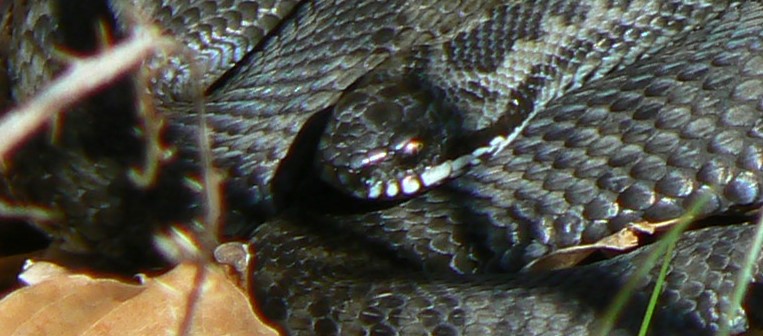
[359] Viperus berus, Adder or Viper
Introduction
Viperus berus, the Adder or Viper, is the only poisonous snake found in the UK, but it not considered to be dangerous.
It has many common names. While Adder and Viper are used interchangeably, either one may be preceded by Common or European or both. Then there are Northern Viper, and (Common) Cross (or Crossed) Viper (or Adder.) It has other local names in the countries of Europe.
All the other species of Vipera and most of the family Viperidae are called Vipers. The name Adder is used only for Vipera berus (and a few other completely unrelated species of snakes!)
Taxonomy
Kingdom – Animals
Phylum – Chordates
Class – Reptiles
Order – Squamata (Lizards and snakes)
Suborder – Serpentes (Snakes)
Infraorder – Alethinophidia (all snakes except blind snakes)
Clade – Afrophidia
Clade – Caenophidia
Clade – Colubroides
Family – Viperidae (Vipers)
Subfamily – Viperinae
Genus – Vipera
Scientific Name – Vipera berus
It has dozens of scientific synonyms and its three subspecies are sometimes ranked as separate species.
Name
Adder comes from nædre, an Old English word for a snake or serpent as used in early translations of the Book of Genesis (where Adam and Eve were tempted by a serpent.) ‘A nædre’ has become ‘an adder’ in the same way that ‘a napron’ became ‘an apron’, and ‘a nompere’ became ‘an umpire.’ Conversely ‘an otch’ became ‘a notch’; ‘an ewte’ became ‘a newt’; and ‘an eke-name’ became ‘a nickname.’
[There are many such examples of re-bracketing. We even have ammunition, which was changed in French from ‘la munition’ to l’amunition; and daffodil from asphodel, which picked up the Dutch article in ‘de affodil.’]
Viper, from the Latin vipera, probably from vivus-pario, giving birth to live young. Berus is New Latin from Greek, meaning true or authentic as the most common snake of ancient Europe. As ‘vipera’ is feminine, I’m not sure why ‘berus’ looks masculine.
Description
The Adder is a typical snake and I won’t tell you what a snake looks like. It grows to a length of about half a metre. The most common form for females has a light brown body with zigzag patterns of darker brown.

Males are similar but grey rather than black.
It feeds on small mammals, birds, lizards and amphibians and also small invertebrates like spiders, insects and worms. They hibernate in winter and may be seen in summer basking in the sum to warm themselves up.
The female produces live young every two or three years. She does not support the young before birth in the same way as mammals. The process is like laying her eggs internally and letting them develop before the young snakes emerge.
They are venomous but not aggressive and will not normally bite unless provoked. The bite is not normally fatal.
[I see many heated debates on Facebook about the difference between ‘venomous’ and ‘poisonous’ but to the layman the terms are much the same.]
Habitat
The main subspecies Vipera berus berus is found over Northern Europe including the island of Britain (but not the island of Ireland,) and Northern France – but not Italy or the Iberian Peninsula. The two other species are found further East.
Other Notes
The adder comes in two colour forms. The melanistic form is all black.

This form is fairly common in females and less common in males.
See also
Snakes are not easy to spot but these are the other possibilities in the UK.
- Natrix Helvetica, the Barred Grass Snake, lives near water and feeds almost exclusively on frogs and toads. It is found in England, Wales (and southern Scotland) and parts of Europe. Until 2017 it was considered a subspecies of the Grass Snake, Natrix natrix Helvetica, but it has now been classified as a separate species.
- Coronella austriaca, the Smooth Snake, is found across Europe but its distribution in England is restricted to a few very small locations in the South
- Anguis fragilis, the Slow-worm, may also be found in Britain, where it tends to remain hidden under vegetation. It looks like a snake but is actually a legless lizard.
